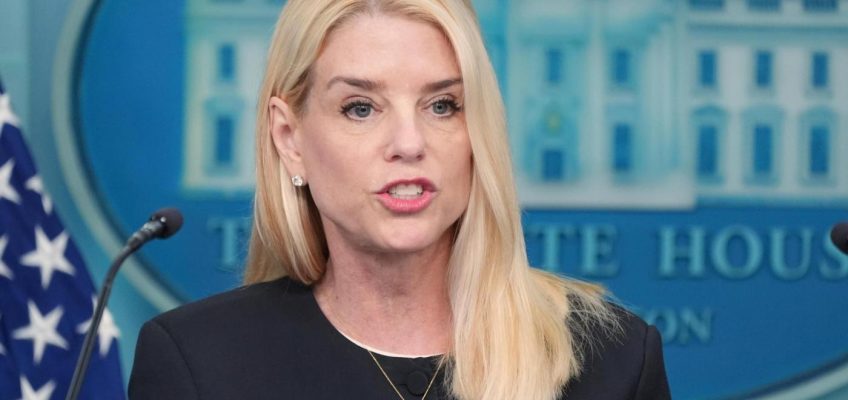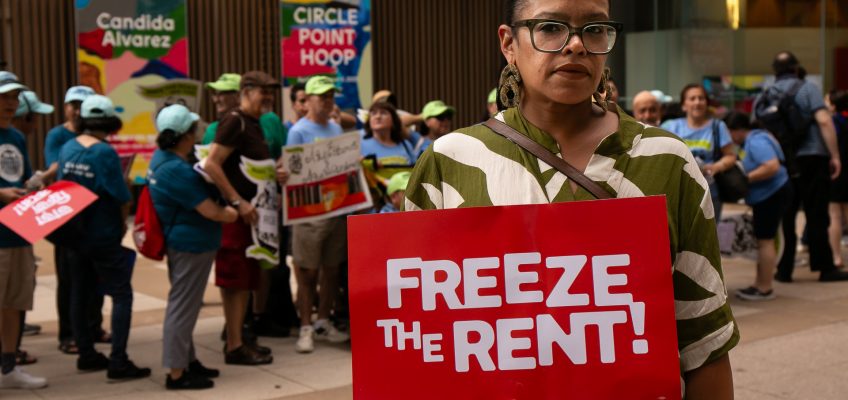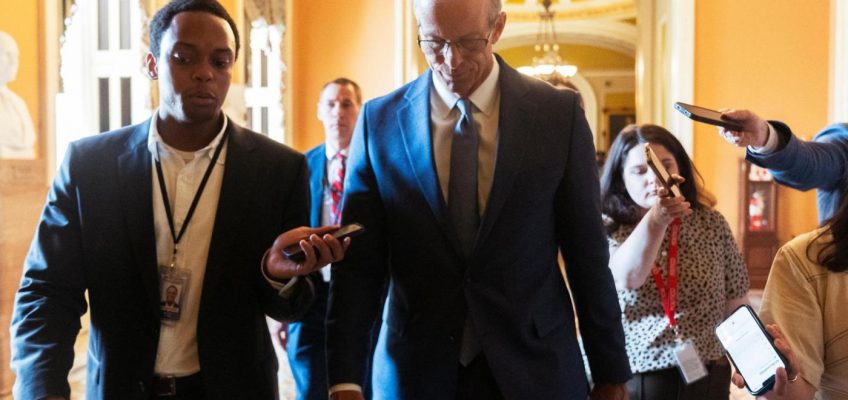By ERIC TUCKER and ALANNA DURKIN RICHER
WASHINGTON (AP) — It was a surprising statement from Attorney General Pam Bondi as the Trump administration promises to release more files from its sex trafficking investigation of Jeffrey Epstein: The FBI, she said, was reviewing “tens of thousands of videos” of the wealthy financier “with children or child porn.”
The comment, made to reporters at the White House days after a similar remark to a stranger with a hidden camera, raised the stakes for President Donald Trump’s administration to prove it has in its possession previously unseen compelling evidence. That task is all the more pressing after an earlier document dump that Bondi hyped angered elements of Trump’s base by failing to deliver new bombshells and as administration officials who had promised to unlock supposed secrets of the so-called government “deep state” struggle to fulfill that pledge.
Yet weeks after Bondi’s remarks, it remains unclear what she was referring to.
The Associated Press spoke with lawyers and law enforcement officials in criminal cases of Epstein and socialite former girlfriend Ghislaine Maxwell who said they hadn’t seen and didn’t know of a trove of recordings like what Bondi described. Indictments and detention memos do not reference the existence of videos of Epstein with children, and neither was charged with possession of child sex abuse material even though that offense would have been much easier to prove than the sex trafficking counts they faced.
One potential clue may lie in a little-noticed 2023 court filing — among hundreds of documents reviewed by the AP — in which Epstein’s estate was revealed to have located an unspecified number of videos and photos that it said might contain child sex abuse material. But even that remains shrouded in secrecy with lawyers involved in that civil case saying a protective order prevents them from discussing it.
The filing suggests a discovery of recordings after the criminal cases had concluded, but if that’s what Bondi was referencing, the Justice Department has not said.
The department declined repeated requests from the AP to speak with officials overseeing the Epstein review. Spokespeople did not answer a list of questions about Bondi’s comments, including when and where the recordings were procured, what they depict and whether they were newly discovered as authorities dug through their evidence collection or were known for some time to have been in the government’s possession.
“Outside sources who make assertions about materials included in the DOJ’s review cannot speak to what materials are included in the DOJ’s review,” spokesperson Chad Gilmartin said in a statement.
FILE – This photo provided by the New York State Sex Offender Registry shows Jeffrey Epstein, March 28, 2017. (New York State Sex Offender Registry via AP, File)
Bondi has faced pressure after first release fell short of expectations
Epstein’s crimes, high-profile connections and jailhouse suicide have made the case a magnet for conspiracy theorists and online sleuths seeking proof of a coverup. Elon Musk entered the frenzy during his acrimonious fallout with Trump when he said without evidence in a since-deleted social media post that the reason the Epstein files have yet to be released is that the Republican president is featured in them.
During a Fox News Channel interview in February, Bondi suggested an alleged Epstein “client list” was sitting on her desk. The next day, the Justice Department distributed binders marked “declassified” to far-right influencers at the White House, but it quickly became clear much of the information had long been in the public domain. No “client list” was disclosed, and there’s no evidence such a document exists.
The flop left conservatives fuming and failed to extinguish conspiracy theories that for years have spiraled around Epstein’s case. Right wing-personality Laura Loomer called on Bondi to resign, branding her a “total liar.”
Afterward, Bondi said an FBI “source” informed her of the existence of thousands of pages of previously undisclosed documents and ordered the bureau to provide the “full and complete Epstein files,” including any videos. Employees since then have logged hours reviewing records to prepare them for release. It’s unclear when that might happen.
Today in History: July 1, Judge Clarence Thomas nominated to the Supreme Court
US brings charges in North Korean remote worker scheme that officials say funds weapons program
6 killed in a crash of a small plane in Ohio, officials say
Judge again delays Abrego Garcia’s release from Tennessee jail over deportation concerns
More than 300 charged in $14.6 billion health care fraud schemes takedown, Justice Department says
In April, Bondi was approached in a restaurant by a woman with a hidden camera who asked about the status of the Epstein files release. Bondi replied that there were tens of thousands of videos “and it’s all with little kids,” so she said the FBI had to go through each one.
After conservative activist James O’Keefe, who obtained and later publicized the hidden-camera video, alerted the Justice Department to the encounter, Bondi told reporters at the White House: “There are tens of thousands of videos of Epstein with children or child porn.”
The comments tapped into long-held suspicions that, despite the release over the years of thousands of records documenting Epstein’s activities, damaging details about him or other prominent figures remain concealed.
The situation was further muddied by recent comments from FBI Director Kash Patel to podcaster Joe Rogan that did not repeat Bondi’s account about tens of thousands of videos.
Though not asked explicitly about Bondi, Patel dismissed the possibility of incriminating videos of powerful Epstein friends, saying, “If there was a video of some guy or gal committing felonies on an island and I’m in charge, don’t you think you’d see it?” Asked whether the narrative “might not be accurate that there’s video of these guys doing this,” he replied, “Exactly.”
FILE – Ghislaine Maxwell, daughter of late British publisher Robert Maxwell, reads a statement expressing her family’s gratitude to Spanish authorities after recovery of his body, Nov. 7, 1991, in Tenerife, Spain. (AP Photo/Dominique Mollard, File)
Epstein took his own life before he could stand trial
Epstein’s suicide in August 2019, weeks after his arrest, prevented a trial in New York and cut short the discovery process in which evidence is shared among lawyers.
But even in a subsequent prosecution of Maxwell, in which such evidence would presumably have been relevant given the nature of the accusations against an alleged co-conspirator, salacious videos of Epstein with children never surfaced nor were part of the case, said one of her lawyers.
“We were never provided with any of those materials. I suspect if they existed, we would have seen them, and I’ve never seen them, so I have no idea what she’s talking about,” said Jeffrey Pagliuca, who represented Maxwell in a 2021 trial in which she was convicted of luring teenage girls to be molested by Epstein.
To be sure, photographs of nude or seminude girls have long been known to be part of the case. Investigators recovered possibly thousands of such pictures while searching his Manhattan mansion, and a videorecorded walk-through by law enforcement of his Palm Beach, Florida, home revealed sexually suggestive photographs displayed inside, court records show.
Accounts from more than one accuser of feeling watched or seeing cameras or surveillance equipment in Epstein’s properties have contributed to public expectations of sexual recordings. A 2020 Justice Department Office of Professional Responsibility report on the handling of an earlier Epstein investigation hinted at that possibility, saying police who searched his Palm Beach home in 2005 found computer keyboards, monitors and disconnected surveillance cameras, but the equipment — including video recordings and other electronic items — was missing.
There’s no indication prosecutors obtained any missing equipment during the later federal investigation, and the indictment against him included no recording allegations.
An AP review of hundreds of documents in the Maxwell and Epstein criminal cases identified no reference to tens of thousands of videos of Epstein with underage girls.
“I don’t recall personally ever having that kind of discussion,” said one Epstein lawyer, Marc Fernich, who couldn’t rule out such evidence wasn’t located later. “It’s not something I ever heard about.”
In one nonspecific reference to video evidence, prosecutors said in a 2020 filing that they would produce to Maxwell’s lawyers thousands of images and videos from Epstein’s electronic devices in response to a warrant.
But Pagliuca said his recollection was those videos consisted largely of recordings in which Epstein was “musing” into a recording device — “Epstein talking to Epstein,” he said.
A revelation from the Epstein estate
Complicating efforts to assess the Epstein evidence is the volume of accusers, court cases and districts where legal wrangling has occurred, including after Epstein’s suicide and Maxwell’s conviction.
The cases include 2022 lawsuits in Manhattan’s federal court from an accuser identified as Jane Doe 1 and in the U.S. Virgin Islands, where Epstein had a home, alleging that financial services giant JPMorgan Chase failed to heed red flags about him being a “high-risk” customer.
Lawyers issued a subpoena for any video recordings or photos that could bolster their case.
They told a judge months later the Epstein estate had alerted them that it had found content that “might contain child sex abuse imagery” while responding to the subpoena and requested a protocol for handling “videorecorded material and photographs.” The judge ordered representatives of Epstein’s estate to review the materials before producing them to lawyers and to alert the FBI to possible child sexual abuse imagery.
Court filings don’t detail the evidence or say how many videos or images were found, and it’s unclear whether the recordings Bondi referenced were the same ones.
The estate’s disclosure was later included by a plaintiffs’ lawyer, Jennifer Freeman, in a complaint to the FBI and the Justice Department asserting that investigators had failed over the years to adequately collect potential evidence of child sex abuse material.
Freeman cited Bondi’s comments in a new lawsuit on behalf of an Epstein accuser who alleges he assaulted her in 1996. In an interview, Freeman said she had not seen recordings and had no direct knowledge but wanted to understand what Bondi meant.
“I want to know what she’s addressing, what is she talking about — I’d like to know that,” she said.
Associated Press journalist Aaron Kessler in Washington contributed to this report.




